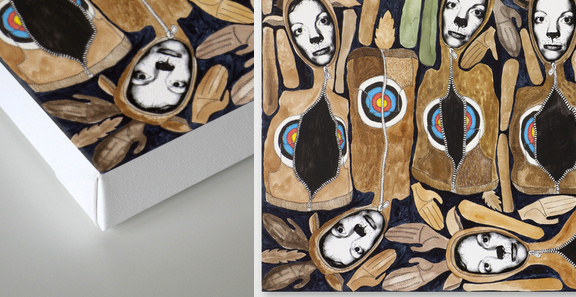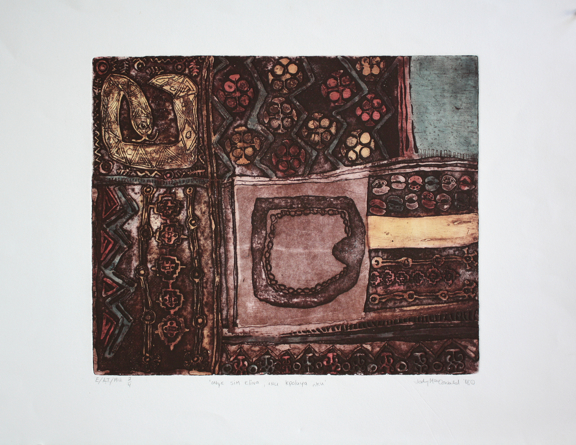Po-tay-to, Po-tah-to: An Art Print Primer
As I prepare for my upcoming Spring Studio Sale I’m reminded of of a semantics issue that artists who engage in printmaking are regularly plagued with: despite sharing the colloquial term “print”, a print that is made using fine art printmaking processes is quite different from a piece of art (such as a painting or drawing) that is made into a print.
I recall past conversations with my mom…me doggedly trying to explain that the prints I was producing were in no way similar to the framed, mass produced art “prints” that were being sold at KMart. I’m pretty sure my mom was pulling my leg, amused by my rising frustration at her feigned, “A print is a print is a print, right?”. But in all honesty, it’s a misunderstanding that many folks make…it can be so damned confusing if you aren’t privy to the difference.
What IS the difference between a repro print and an artist made print?
When you buy a print that is a copy of an original (painting, drawing, etc.) you are buying a reproduction (the top end of these are high quality photo-mechanical copies made with archival pigments and printed on archival paper or canvas).

REPRODUCTION PRINT: P.O.D. reproduction of Incomplete Hunt (ink, watercolour and collage drawing) available at society6.
When you buy a print that an artist has pulled from a plate using traditional printmaking processes (intaglio, etching, lino cut, to name but a few), you are not getting a reproduction of an original work – the print IS the original work. That’s part of the allure of printmaking – many “identical” originals can be created off the same plate.
[What’s a “plate”, you ask? “Plate” is a general term referring to the surface that the artist “inks up”. It can be prepared metal (etching, intaglio, drypoint, aquatint, etc); carved linoleum (linocut); Plexiglas (monoprints, drypoint); cardboard (collagraph); etc. Sometimes this surface is referred to as the template or “matrix” and can also be made of stone (lithography), wood blocks (woodcuts), or screens (serigraph).]
Both artist-pulled prints and commercial reproductions are generally printed in “editions”. An edition is a set of originals that an artist has pulled from the same plate, or in the case of reproductions, a set of reproductions that have been produced in the same printing run (NB – all prints in the edition should look essentially identical to one another). “Limited edition” means the number of prints is finite to a predetermined amount, and each print is numbered accordingly (i.e. 1/200, 2/200, etc.).
Back in the day before digital printing was all the rage, an artist who wanted to have a limited edition run of reproductions made would take their painting or drawing to a professional printer where it would be photographed, colour separated, and printed off big ol’ commercial presses. The initial set up for this was pricey – not really cost effective for small editions so it made sense for the “limited” editions to be large-ish (think in the hundreds).
Editions in an artist original print, made with traditional printmaking processes, are generally much smaller. In some cases this is due to the delicateness of the “plate” or printing surface. At a certain point in the edition, the details and quality of the plate can noticeably deteriorate. Some printmaking methods force artists to keep editions small; a metal acid etch or drypoint plate will break down with each print that is pulled resulting in inferior prints if you try to push the limit of your edition (printing presses exert an exceptional amount of pressure on a surface!). In my printmaking heyday, I found that my intaglios on zinc plates were good up to an edition size of only 10 prints.
These days, through the wonder of digital magic, it is very common for artists to take a high res photo or digital scan of an original and then have a printing company or print-on-demand (POD) service (i.e. society6, Zazzle) produce open-ended reproductions. In addition, artists who own a high-quality archival printer have the ability to produce POD reproductions themselves.
Is there a way to visually determine if a print is an original or reproduction?
Yup. There are several visual factors that can help a viewer determine if a print is a reproduction or an original. Here are a few of the easy-to-spot ones:
- Original prints often have the method(s) used in the artwork’s process listed at the far bottom left of the work (MV = multiple viscosity; AT = Aquatint, etc.). Reproductions don’t.
- Original prints, depending on the method used, will have evidence of being run through a press – the shape of the plate embossed into the paper. The surface of a reproduction is generally flat and smooth (FYI, some repros are printed on canvas embossed to give the effect of brushstrokes and a closer inspection will show the pattern to be a bit mechanical).
- As mentioned above, the size of the edition listed on the print is a good indication of whether the print is an original or reproduction. Original artist-pulled prints are typically produced in small numbers. If an edition size is quite large, or there is no edition number (open-ended run), then it is probably a reproduction.
Is there a difference in value between a print and a reproduction?
Well, yes…and no.
If we follow the rules of simple supply and demand, an original, artist-pulled print in a limited edition of 10 “should” be considered more valuable than a reproduction print that is in a limited edition of 200 or more (additionally, a reproduction print that is in a limited edition of 200 “should” be considered more valuable than an open-ended print run). The idea behind small editions is that the end product is less common and therefore more valuable…think Scrabble and the difference in value between the letter X and the letter E.
But in the highly subjective business of art it isn’t as clear cut as all that. Many factors influence the value of a print or reproduction – a key one being the reputation of the artist. High-number edition art reproductions – marketed as “prints” – may be priced higher than an artist’s original print if the reproduction is by, oh, say…Robert Bateman.
I’m not implying that original prints are better than reproductions – just different. I think both have a legitimate place in the art market – reproductions allow artists a better chance of making a sustainable income off of their work, capitalizing on their effort and making their work available to a wider audience. Original prints and reproduction prints are, however, very distinct beasts despite sharing common terminology and folks who are buying deserve to be in-the-know.
Have you ever bought something and then discovered it was quite different than what you thought you were buying because of how it was presented? Please share your story in the comments below.
